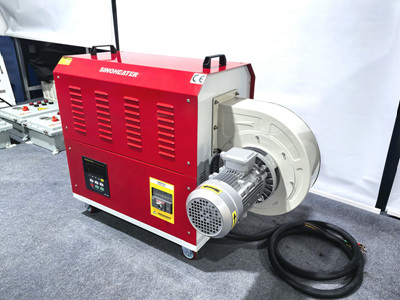Key Factors to Evaluate When Assessing the User-Friendliness of Heat Blower Operation Interfaces
The operation interface of a heat blower directly impacts productivity, safety, and maintenance efficiency in industrial or commercial settings. A poorly designed interface can lead to misconfiguration, delayed troubleshooting, or accidental shutdowns, especially in high-stress environments. Below are critical aspects to consider when evaluating how intuitive and functional a heat blower’s control system is for daily use.
Intuitive Layout and accessibility of essential controls
Logical Grouping of Functions for Quick Adjustments
A user-friendly interface organizes controls by frequency of use. For example, power, temperature, and airflow settings should be grouped together on the main panel, while diagnostic tools or advanced settings are tucked into submenus. This reduces the time operators spend searching for functions, minimizing errors during urgent adjustments. Look for interfaces that follow industry-standard layouts, such as vertical sliders for temperature or rotary dials for fan speed, which align with common user expectations.
Color-Coding and Symbols for Universal Understanding
Visual cues like color-coded buttons (red for emergency stop, green for start) or standardized symbols (e.g., a flame icon for heating mode) help operators interpret controls without language barriers or extensive training. Ensure symbols comply with ISO 7000 or ANSI Z535 standards, which define globally recognized icons for safety and operation. Avoid abstract graphics or text-heavy labels, as these can confuse users under time pressure or in low-light conditions.
Physical Button Durability for Harsh Environments
In dusty, wet, or high-vibration settings, touchscreens may become unresponsive or damaged. Opt for heat blowers with rugged physical buttons or membrane keypads rated IP65 or higher for resistance to water and dust ingress. Tactile feedback (e.g., audible clicks or resistance) confirms button presses, reducing accidental inputs. Some models combine physical controls with a small digital display for balance, offering reliability without sacrificing readability.
Real-Time Monitoring and feedback mechanisms
Clear Digital Displays for Key Performance Metrics
A high-contrast LCD or LED screen showing real-time data—such as outlet temperature, airflow rate, or energy consumption—enables operators to verify system performance instantly. Choose displays with adjustable brightness or backlighting to ensure visibility in bright sunlight or dark rooms. Multi-line displays are preferable, as they can show alarms, settings, and unit measurements simultaneously without requiring navigation through menus.
Audible and Visual Alarms for Immediate Issue Detection
Critical faults (e.g., overheating, motor failure, or filter clogs) should trigger loud alarms and flashing lights to alert nearby personnel, even in noisy environments. Alarms should be distinguishable by tone or pattern (e.g., a continuous beep for overheating vs. intermittent pulses for low airflow) to help operators prioritize responses. Some interfaces allow customization of alarm thresholds or silence durations to prevent nuisance alerts during planned maintenance.
Historical Data Logging for Predictive Maintenance
Advanced interfaces store operational history, such as runtime hours, temperature fluctuations, or error codes, which helps technicians diagnose recurring issues or schedule proactive maintenance. Look for units with USB ports or wireless connectivity (e.g., Wi-Fi or Bluetooth) to export data logs for analysis for software tools. This feature is particularly valuable in facilities aiming to reduce downtime through condition-based maintenance strategies.
Customization and integration with existing systems
Multi-Language Support for Diverse Workforces
Global operations require interfaces that accommodate operators who speak different languages. Ensure the heat blower’s menu system supports at least three languages (e.g., English, Spanish, Mandarin) and allows switching without resetting settings. Some models use pictograms or universal symbols alongside text to bridge language gaps, improving accessibility for temporary workers or contractors unfamiliar with the primary language.
Programmable Presets for Repeated Tasks
In applications requiring frequent adjustments (e.g., switching between heating and drying modes), programmable presets save time and reduce errors. Operators can store preferred temperature, airflow, and timer settings for specific tasks and recall them with a single button press. This feature is especially useful in facilities with shift changes, as it ensures consistent operation regardless of the operator’s experience level.
Compatibility with Building Management Systems (BMS) for Centralized Control
For large-scale installations, the heat blower’s interface should integrate with BMS platforms like BACnet, Modbus, or LonWorks. This allows remote monitoring and adjustment via a central dashboard, eliminating the need for manual checks at each unit. Verify that the interface supports open protocols (rather than proprietary ones) to avoid vendor lock-in and ensure compatibility with future upgrades to the BMS infrastructure.
Training and documentation for seamless onboarding
Interactive Tutorials for First-Time Users
Some interfaces include step-by-step tutorials that guide operators through setup, calibration, or emergency procedures. These tutorials can be activated during initial startup or accessed via a dedicated “help” button. Interactive elements (e.g., highlighting buttons or displaying animated workflows) improve retention compared to static manuals, reducing the learning curve for new hires.
Quick-Reference Guides Mounted Near the Unit
Physical or laminated guides placed beside the heat blower provide instant access to troubleshooting steps, safety procedures, or contact information for technical support. These guides should use the same symbols and color-coding as the interface to maintain consistency. Ensure they are weatherproof and legible from a distance to accommodate operators wearing gloves or safety goggles.
Online Resources and Mobile Apps for Remote Support
Manufacturers that offer digital manuals, video tutorials, or mobile apps enhance user-friendliness by enabling operators to access help from smartphones or tablets. Some apps include augmented reality (AR) features that overlay instructions onto the physical interface via a camera, simplifying complex tasks like sensor calibration or firmware updates. Check if these resources are regularly updated to reflect software changes or new safety regulations.
By prioritizing intuitive layouts, real-time feedback, customization options, and comprehensive training tools, buyers can select heat blowers with operation interfaces that minimize errors, streamline maintenance, and adapt to evolving workforce needs. Color-coded controls, programmable presets, and BMS compatibility ensure long-term usability, while digital tutorials and quick-reference guides accelerate onboarding for new operators.



